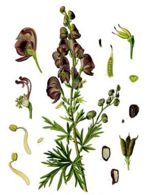Monkshood
| Monkshood |
|---|

|
| Scientific Classification |
|
| Species |
|
Monkshood are any of the species of flowering plants belonging to the taxonomic genus Aconitum. They are herbaceous, perennial plants that are typically found naturally-occurring in the northern hemisphere.
Anatomy
Monkshood are usually identified by their unique flowers that posses five petal-like sepals, one of which takes on the form of a cylindrical helmet; this contributes to one of their species names: monkshood (i.e. Aconitum napellus) [1]. These flowers are usually white, pink, blue, yellow, or purple and have numerous stamens [2]. The stems are typically three feet high [3] and their dark green leaves lack stipules and are typically found in spiral or alternate arrangements [4].
Reproduction
Species of aconite is cultivated in two main ways: raised from seed or by division of the roots in the autumn [5]. Aconitum produce sexually in the wild via a stamen and ovary [6], and are fertilized by bumblebees [7]. Aconitum usually bloom in July, August, and September [8] and tend to prefer moist, open areas [9] in full light or part-shade [10]. The fruits of these hardy perennials are follicles [11]. Aconitum are cultivated via division of the roots by digging up the roots after the stem has died and harvesting the “daughter roots” that have grown off of the main root system and replanting them sometime in December or January. The aconitum grown this way are continued by the “daughter roots" [12].
Ecology
These plants, when used in homoeopathy [13] or medicine, are incredibly useful despite its classification as a deadly poison [14]. Aconitum napellus, one of the most common varieties, is of both therapeutic and toxicological importance to “modern” man. Besides these obvious qualities it also makes a lovely addition to a garden, but care must be taken due to its poisonous nature. It is also used as a source of food by various Lepidoptera species [15].
Gallery
Related References
- Aconitum - Wikipedia
- Aconite - Botanical.com, "A Modern Herbal" by Mrs. M. Grieve
- ACONITUM MONKSHOOD, ACONITE, WOLFBANE Ranunculaceae (Buttercup family) - Pacific Rim: native plant nursery




